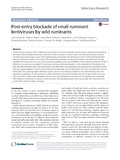Mostrar el registro sencillo del ítem
Post-entry blockade of small ruminant lentiviruses by wild ruminants
| dc.creator | Sanjosé, Leticia | es_ES |
| dc.creator | Crespo, Helena | es_ES |
| dc.creator | Blatti-Cardinaux, Laure | es_ES |
| dc.creator | Glaría Ezquer, Idoia | es_ES |
| dc.creator | Martínez Carrasco, Carlos | es_ES |
| dc.creator | Berriatua, Eduardo | es_ES |
| dc.creator | Amorena Zabalza, Beatriz | es_ES |
| dc.creator | Andrés Cara, Damián de | es_ES |
| dc.creator | Bertoni, Giuseppe | es_ES |
| dc.creator | Reina Arias, Ramsés | es_ES |
| dc.date.accessioned | 2016-02-10T09:46:46Z | |
| dc.date.available | 2016-02-10T09:46:46Z | |
| dc.date.issued | 2016 | |
| dc.identifier.issn | 0928-4249 (Print) | |
| dc.identifier.issn | 1297-9716 (Electronic) | |
| dc.identifier.uri | https://hdl.handle.net/2454/20011 | |
| dc.description.abstract | Small ruminant lentivirus (SRLV) infection causes losses in the small ruminant industry due to reduced animal production and increased replacement rates. Infection of wild ruminants in close contact with infected domestic animals has been proposed to play a role in SRLV epidemiology, but studies are limited and mostly involve hybrids between wild and domestic animals. In this study, SRLV seropositive red deer, roe deer and mouflon were detected through modified ELISA tests, but virus was not successfully amplified using a set of different PCRs. Apparent restriction of SRLV infection in cervids was not related to the presence of neutralizing antibodies. In vitro cultured skin fibroblastic cells from red deer and fallow deer were permissive to the SRLV entry and integration, but produced low quantities of virus. SRLV got rapidly adapted in vitro to blood-derived macrophages and skin fibroblastic cells from red deer but not from fallow deer. Thus, although direct detection of virus was not successfully achieved in vivo, these findings show the potential susceptibility of wild ruminants to SRLV infection in the case of red deer and, on the other hand, an in vivo SRLV restriction in fallow deer. Altogether these results may highlight the importance of surveilling and controlling SRLV infection in domestic as well as in wild ruminants sharing pasture areas, and may provide new natural tools to control SRLV spread in sheep and goats. | en |
| dc.description.sponsorship | Funded by CICYT (AGL2010-22341-C04-01 and AGL2013-49137-C3-1-R) and Navarra’s Government (IIQ010449.RI1 and IIQ14064.RI1). L. Sanjosé was a FPI fellow of the Spanish MINECO and R. Reina had contracts from the Public University of Navarra and CSIC. The auhors acknowledge support in the publication fee by the CSIC Open Access Publication Support Initiative through its Unit of Information Resources for Research (URICI). | en |
| dc.format.mimetype | application/pdf | en |
| dc.language.iso | eng | en |
| dc.publisher | BioMed Central | en |
| dc.relation.ispartof | Veterinary Research (2016) 47:1 | en |
| dc.rights | This article is distributed under the terms of the Creative Commons Attribution 4.0 International License (http://creativecommons.org/licenses/by/4.0/), which permits unrestricted use, distribution, and reproduction in any medium, provided you give appropriate credit to the original author(s) and the source, provide a link to the Creative Commons license, and indicate if changes were made. The Creative Commons Public Domain Dedication waiver (http://creativecommons.org/publicdomain/zero/1.0/) applies to the data made available in this article, unless otherwise stated. | en |
| dc.rights.uri | http://creativecommons.org/licenses/by/4.0/ | |
| dc.rights.uri | http://creativecommons.org/publicdomain/zero/1.0/ | |
| dc.subject | Small ruminants lentiviruses (SRLV) | en |
| dc.subject | Wild ruminants | en |
| dc.subject | Infection | en |
| dc.title | Post-entry blockade of small ruminant lentiviruses by wild ruminants | en |
| dc.type | Artículo / Artikulua | es |
| dc.type | info:eu-repo/semantics/article | en |
| dc.contributor.department | IdAB. Instituto de Agrobiotecnología / Agrobioteknologiako Institutua | es |
| dc.rights.accessRights | Acceso abierto / Sarbide irekia | es |
| dc.rights.accessRights | info:eu-repo/semantics/openAccess | en |
| dc.identifier.doi | 10.1186/s13567-015-0288-7 | |
| dc.relation.projectID | info:eu-repo/grantAgreement/MICINN//AGL2010-22341-C04-01/ES/ | en |
| dc.relation.projectID | info:eu-repo/grantAgreement/MINECO//AGL2013-49137-C3-1-R/ES/ | en |
| dc.relation.publisherversion | https://doi.org/10.1186/s13567-015-0288-7 | |
| dc.type.version | Versión publicada / Argitaratu den bertsioa | es |
| dc.type.version | info:eu-repo/semantics/publishedVersion | en |
| dc.contributor.funder | Gobierno de Navarra / Nafarroako Gobernua: IIQ010449.RI1 | es |
| dc.contributor.funder | Gobierno de Navarra / Nafarroako Gobernua: IIQ14064.RI1 | es |
| dc.contributor.funder | Universidad Pública de Navarra / Nafarroako Unibertsitate Publikoa | es |
Ficheros en el ítem
Este ítem aparece en la(s) siguiente(s) colección(ones)
La licencia del ítem se describe como This article is distributed under the terms of the Creative Commons Attribution 4.0 International License (http://creativecommons.org/licenses/by/4.0/), which permits unrestricted use, distribution, and reproduction in any medium, provided you give appropriate credit to the original author(s) and the source, provide a link to the Creative Commons license, and indicate if changes were made. The Creative Commons Public Domain Dedication waiver (http://creativecommons.org/publicdomain/zero/1.0/) applies to the data made available in this article, unless otherwise stated.



